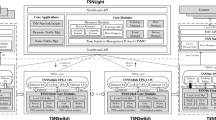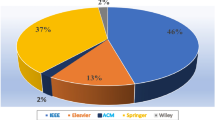Abstract
Dynamic adaptive streaming over HTTP (DASH) has been widely deployed to provide various video services in the Internet. However, the HTTP/1.1 or HTTP/2 utilized by the DASH system cannot ensure high quality of user experience in highly dynamic network scenarios. Specifically, when the clients fetch the video chunks from servers, it is well known that HTTP/1.1 protocol suffers from low utilization due to its stop-wait fashion. Though HTTP/2 enables the servers proactively push multiple chunks to clients on a single request, it exhibits poor adaptability to the network dynamic, since the bitrate of multiple chunks is fixed in one push cycle. To address these inefficiencies, we propose elastic chunk scheduling (ECS) to adaptively adjust the batch size of chunks in each push cycle according to network dynamic. To achieve high utilization, ECS increases the batch size of chunks under low network dynamic. Otherwise, ECS reduces the batch size to flexibly change the bitrate of chunks to avoid rebuffer and overflow at the player buffer. Through achieving good tradeoff between high link utilization and flexible rate switching, ECS improves overall QoE performance. The experimental results of testbed implementations show that ECS greatly decreases the rebuffer ratio by up to 36% and increases the average bitrate by up to 10% compared with the state-of-the-art solutions.















Similar content being viewed by others
References
Sodagar, I.: The MPEG-dash standard for multimedia streaming over the internet. IEEE Multimedia 18(4), 62–67 (2011)
Wei, S., Swaminathan, V.: Low latency live video streaming over HTTP 2.0. In: Proceedings of ACM NOSSDAV, pp. 37–42 (2014)
Balakrishnan, H., Stemm, M., Seshan, S., Katz, R.H.: analyzing stability in wide-area network performance. In: Proceedings of the ACM SIGMETRICS, pp. 2–12 (1997)
Jobin, J., Faloutsos, M., Tripathi, S.K., Krishnamurthy, S.V.: Understanding the effects of hotspots in wireless cellular networks. In: Proceedings of IEEE INFOCOM, pp. 660–671 (2004)
Zhang, Y., Duffield, N.: On the constancy of internet path properties. In: Proceedings of the ACM SIGCOMM Workshop on Internet Measurement (IWM), pp. 197–211 (2001)
Pishro-Nik, H.: Introduction to probability. Statistics and Random Processes, Kappa Research (2014)
DASHDataset. (2014). http://www-itec.uni-klu.ac.at/ftp/datasets/DASHDataset2014/OfForestAndMen/
Xu, S., Mao, Z.M., Sen, S., Jia, Y.: Dissecting VOD services for cellular: performance, root causes and best practices. In: Proceedings of ACM IMC, pp. 220–234 (2017)
Qin, Y., Hao, S., Pattipati, K.R., Qian, F., Sen, S., Wang, B., Yue, C.: ABR streaming of VBR-encoded videos: characterization, challenges, and solutions. In: Proceedings of ACM CoNEXT, pp. 366–378 (2018)
Grigorik, I.: High Performance Browser Networking: What Every Web Developer Should Know About Networking and Web Performance. O’Reilly Media Press (2013)
Yin, X., Jindal, A., Sekar, V., Sinopoli, B.: A Control-theoretic approach for dynamic adaptive video streaming over HTTP. In: Proceedings of ACM SIGCOMM, pp. 325–338 (2015)
GPAC Multimedia Open Source Project. (2019). https://gpac.wp.imt.fr/
Spiteri, K., Urgaonkar, R., Sitaraman, R.K.: BOLA:Near-Optimal Bitrate Adaptation for Online Videos. IEEE/ACM Trans. Netw. 28(4), 1698–1711 (2020)
Spiteri, K., Sitaraman, R., Sparacio, D.: From theory to practice: improving bitrate adaptation in the DASH reference player. ACM Trans. Multimed. Comput. Commun. Appl. 15(2), 1–29 (2019)
Watching video in 4K ultra HD on Fire TV. (2016). https://www.amazon.co.uk/gp/help/customer/display.html?nodeId=
Recommended upload encoding settings. (2017). https://support.google.com/youtube/answer/1722171?hl=en-GB
Meng, Z., Chen, J., Guo, Y., Sun, C., Xu, H., Xu, M.: Pitree: practical implementation of abr algorithms using decision trees. In Proceedings of ACM MM, pp. 2431–2439 (2019)
Li, W., Huang, J., Zou, S., Liu, Z., Su, Q., Chen, X., Wang, J.: Pipeline-based chunk scheduling to improve abr performance in DASH system. In: Proceedings of IEEE ICCCN, pp. 1–9 (2020)
Riiser, H., Vigmostad, P., Griwodz, C., Halvorsen, P.: Commute path bandwidth traces from 3G networks: analysis and applications. In: Proceedings of ACM MMSYS, pp. 114–118 (2013)
derHooft, J.V., Petrangeli, S., Wauters, T., Huysegems, R., Alface, P.R., Bostoen, T., Turck, F.D.: HTTP/2-based adaptive streaming of HEVC video over 4G/LTE networks. IEEE Commun. Lett. 20(11), 2177–2180 (2016)
Raw Data-Measuring Broadband America. (2016). https://www.fcc.gov/reports-research/reports/measuring-broadbandamerica/raw-data-measuring-broadband-america-2016
Mueller, C., Lederer, S., Timmerer, C., Hellwagner, H.: dynamic adaptive streaming over HTTP/2.0. In: Proceedings of IEEE ICME, pp. 1–6 (2013)
Huysegems, R., Hooft, J.V., Bostoen, T., Alface, P.R., Petrangeli, S., Wauters, T., Turck, F.D.: HTTP/2-Based methods to improve the live experience of adaptive streaming. In: Proceedings of ACM MM, pp. 541–550 (2015)
Wei, S., Swaminathan, V.: Cost effective video streaming using server push over HTTP 2.0. In: Proceedings of IEEE MMSP, pp. 1–5 (2014)
Xiao, M., Swaminathan, V., Wei, S., Chen, S.: DASH2M: exploring HTTP/2 for internet streaming to mobile devices. In: Proceedings of ACM MM, pp. 22–31 (2016)
Xu, Z., Zhang, X., Guo, Z.: QoE-driven adaptive K-push for HTTP/2 live streaming. IEEE Trans. Circ. Syst. Video Technol. 29(6), 1781–1794 (2018)
Petrangeli, S., Swaminathan, V., Hosseini, M., Turck, F.D.: An HTTP/2-based adaptive streaming framework for 360\(^o\) virtual reality videos. In: Proceedings of ACM MM, pp. 306–413 (2017)
Xiao, M., Zhou, C., Swaminathan, V., Liu, Y., Chen, S.: BAS-360\(^o\): exploring spatial and temporal adaptability in 360-degree videos over HTTP/2. In: Proceedings of IEEE INFOCOM, pp. 953–961 (2018)
Jiang, J., Sekar, V., Zhang, H.: Improving fairness, efficiency, and stability in HTTP-based adaptive video streaming with FESTIVE. In: Proceedings of ACM CoNEXT, pp. 97–108 (2012)
Huang, T.Y., Johari, R., McKeown, N., Trunnell, M., Watson, M.: A buffer-based approach to rate adaptation: evidence from a large video streaming service. In: Proceedings of ACM SIGCOMM, pp. 187–198 (2014)
Akhtar, Z., Nam, Y.S., Govindan, R., Rao, S., Chen, J., Bassett, E.K., Ribeiro, B., Zhan, J., Zhang, H.: Oboe: auto-tuning video ABR algorithms to network conditions. In: Proceedings of ACM SIGCOMM, pp. 44–58 (2018)
Hajiesmaili, M.H., Khonsari, A., Sehati, A., Talebi, M.S.: Content-aware rate allocation for efficient video streaming via dynamic network utility maximization. J. Netw. Comput. Appl. 35(6), 2016–2027 (2012)
Garcia, J.S., Castell, S.F., Pineda, M.G.: Performance evaluation of different techniques to estimate subjective quality in live video streaming applications over LTE-Advance mobile networks. J. Netw. Comput. Appl. 107(1), 22–37 (2018)
Gadaleta, M., Chiariotti, F., Rossi, M., Zanella, A.: D-DASH: a deep Q-learning framework for DASH video streaming. IEEE Trans. Cogn. Commun. Netw. 3(4), 703–718 (2017)
Mao, H., Netravali, R., Alizadeh, M.: Neural adaptive video streaming with pensieve. In: Proceedings of ACM SIGCOMM, pp. 197–210 (2017)
Acknowledgments
This work was supported by Natural Science Foundation of Hunan Province, China (2021JJ30867), National Natural Science Foundation of China (62132022, 61872387), Project of Foreign Cultural and Educational Expert (G20190018003).
Author information
Authors and Affiliations
Corresponding author
Additional information
Publisher's Note
Springer Nature remains neutral with regard to jurisdictional claims in published maps and institutional affiliations.
Rights and permissions
About this article
Cite this article
Huang, J., Liu, Z., Liu, J. et al. Achieving High Utilization by Elastic Chunk Scheduling in DASH Systems. J Netw Syst Manage 30, 16 (2022). https://doi.org/10.1007/s10922-021-09628-2
Received:
Revised:
Accepted:
Published:
DOI: https://doi.org/10.1007/s10922-021-09628-2




